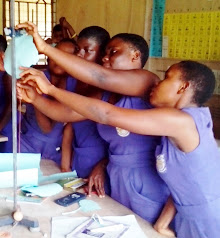We are delighted to report that the urine diversification/dehydration toilet (UDDT) project at Methodist-Government school is moving right along. The contractor, Mr. Emmanuel Appiah, sends photos every few days via the miracle of "Whatsapp!"
Thanks to the Engineers Without Borders team that trained
Mr. Appiah’s crew in 2014 on the first UDDT project, the Ghanaians now
know how to construct this type of toilet.
 |
| Students helping carry materials to the building site |
 |
In keeping with their traditional way of handling this, they are building urinals on each end---one for boys and one for girls. Above, you see the girls' urinal, with a separate, semi-private compartment on the right for handling their menstrual needs. A container capturing rain water will also be installed in that compartment, so girls can rinse out their "cloths", wash their hands, etc. The center section (colored bricks) is private "stalls"---each one can handle both urine and feces and provides privacy..
|
We have been forwarding Mr. Appiah’s photos to the EWB leadership
in Bellingham, WA who have helped out by noticing some details that needed to
be remedied. Thanks!
This is international teamwork at the local level! For
those of us of a certain age, we can only say “Who would have thought?”
 |
Workmen installing the "doors" to the feces compartments. Each "stall" has two such "cisterns", as the compartments are called. The students use one cistern for an entire year. Then it is capped and the other cistern is used. After another year, the first cistern is simply shoveled out, and the dried feces is hauled away as fertilizer (probably to a nearby rubber plantation). EWB-Bellingham is developing an easy way to test feces toxicity, to ensure safe handling.
While these are sanitation projects, they also are science education projects.
Students are gaining a better understanding of their own bodies and how they work. They are understanding the chemistry of urine, the toxicity of feces, and how to handle both in healthful ways.
They are learning how human waste can provide precious fertilizer to crops, if handled properly. Girls can handle their menstrual periods at school, without having to miss precious days, through the special accommodation built into the girls’ urinal.
|
 |
This photo shows the inside arrangement. Students plant their feet on the "foot blocks." One hole will be capped and not used while the other will be used for an entire year. Feces goes down the hole....urine goes forward into the small hole in the center of the basin. The "urine hole" is connected to a pipe, and the urine is diverted to the planted area behind the toilet.
Toilet tissue, newsprint, leaves, menstrual pads, cloth, etc. can go into the feces hole. Anything of plastic cannot. We teach the students to remember that our bodies separate our waste, automatically, and with this type of toilet, we just continue what our bodies already do!
|
With this second toilet project, about 1000 more children
and their teachers are learning about this advanced, low-impact,
no-water-no-electricity toilet design.
 |
| PVC pipe provides ventilation. One of the big advantages of this toilet design is the lack of odor often found in the more common pit toilets. This is especially a problem when one is only 4 degrees from the equator!! The plants shown will be supplemented by many others---avocados, fruit trees, tomatoes, etc. The urine drains through pipes with holes to fertilize the "garden" behind the toilet. |
Pipes will be added to the roof to collect rain water, which flows into secure hand-washing containers.
Maybe a bit more than you wanted to know!!
Of course, other schools in Axim are finding out about these
toilets and they want one, too. Mr. Appiah has offered to donate his own labor
costs completely, and his workers have agreed to donate some of their labor,
too, for any additional UDDTs. They want to help their community.
With Mr. Appiah’s generous offer, each UDDT
costs about $12,000-$15,000, depending on the exchange rate, terrain, etc. (about
a $5000 discount over the original quote). (Note: per James Kainyiah, who does construction himself and is Chair of WHH, our partner organization, this is an honest contractor with honest quote).
So, hey, if you would
like a toilet of your very own, you know who to call! We could name it after
you. We know an artist in Axim who we are sure can make a truly beautiful plaque…
J
Seriously, we have a dream where no one has to use the bush!






